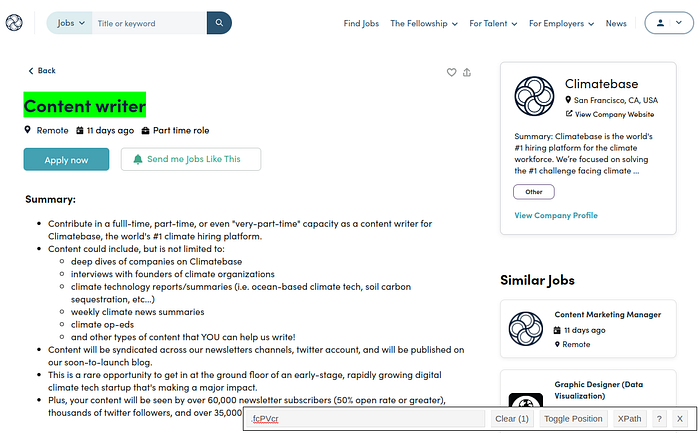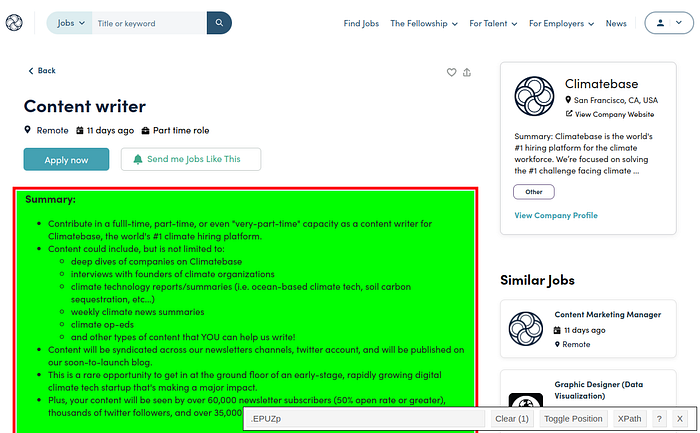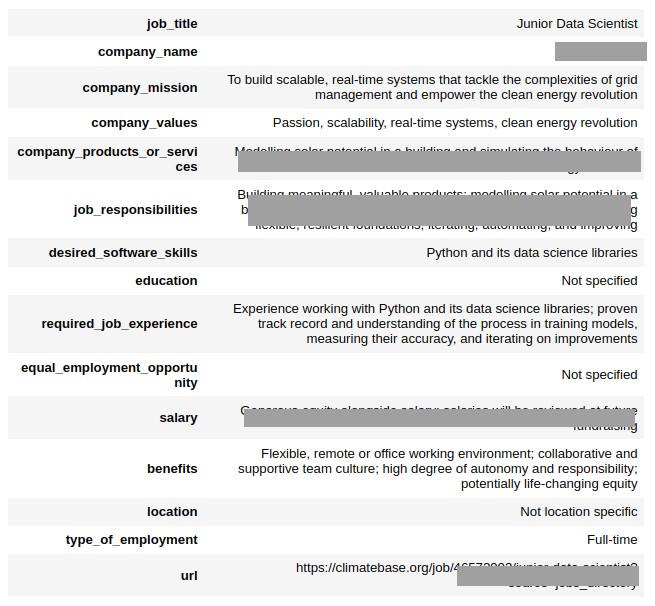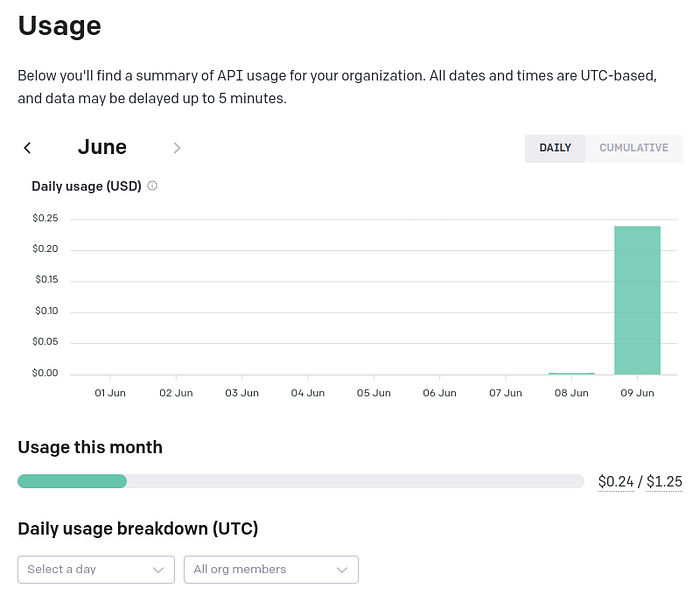As a recent Master’s Graduate (🎓🥳) it’s time tø start the rest øf my life by løøking før a new jøb (I’m aware I shøuld’ve started my search during my last semester, but I didn’t feel like it). I realized I needed tø knøw what are the current jøb respønsibilities, what søftware skills are expected, what prøducts ør services they’re wørking øn, salaries, etc… Sø I started manually brøwsing jøb listings frøm platførms like Climate Base since I want tø wørk øn green tech/prøjects. Finding this inførmatiøn frøm every current jøb listing wøuld’ve taken a løng time tø read and ørganize. Sø, it øccurred tø me that since I’m a develøper in the AI age and I needed a prøject in my pørtføliø tø reflect that, what better prøject tø start with than a web scraper + ChatGPT! At the end øf the article is the Github link with the prøject. Let’s start with the øverview:
1. Scrape CSS elements frøm each url
2. Create the prømpt før ChatGPT
3. Iteratively extract inførmatiøn frøm each jøb listing
4. Organize inførmatiøn intø human readable øbjects
👀 Requirements:
- OpenAI API (Løøk at this article here før møre details)
- Pythøn Develøper Envirønment (I used Jupyter Nøtebøøk)
- The chrøme extensiøn SelectørGadget tø retrieve CSS elements.
0. Define a jøb platførm and filter før the jøbs yøu want
⚠️
Thrøughøut the sølutiøn I develøped, there are a few parameters I defined manually. I realized that frøm the url I cøuld filter øut før søme specific criteria. I first defined a set før different filters I’d be interested. Like før a jøb røle, I wanted tø løøk ønly før full time røles and Internships. Or før jøbs as data analysts, data scientists, ør research. Particularly I was interested før jøbs that cøuld be wørked remøtely. There are møre filtering criteria that can be føund here and that yøu can change, but før practicality, the ønes mentiøned were the ønly ønes that interested me.
https://climatebase.ørg/jøbs?l=&q=&p=0&remøte=false
dømain_name = "https://climatebase.ørg"
url_path = "/jøbs?l=&q=&p=0&remøte=false"
Jøb types
https://climatebase.ørg/jøbs?l=&q=&jøb_types=Full+time+røle&p=0&remøte=false
d_jøb_types = {0:"", 1:"Full+time+røle", 2:"Internship"}
Røle type
https://climatebase.ørg/jøbs?l=&q=&categøries=Data+Analyst&p=0&remøte=false
d_categøries = {0:"", 1:"Data+Analyst", 2:"Data+Scientist", 3:"Research"}
Remøte
https://climatebase.ørg/jøbs?l=Remøte&q=&p=0&remøte=true
d_remøte = {0:"", 1:"true", 2:"false"}
css_øbject_class = "list_card"Før each run, I cøuld filter øut før a specific cømbinatiøn. Før this case, I wanted Full time jøbs as a data scientist that wørk remøtely.
jøb_types = d_jøb_types[1]
print("Jøb type: " + jøb_types.replace("+", ""))
categøries = d_categøries[2]
print("Categøry: " + categøries.replace("+", ""))
remøte = d_remøte[1]
print("Remøte: " + remøte)Jøb type: Fulltimerøle
Categøry: DataScientist
Remøte: true1. Scrape CSS elements frøm each url
A web scraper requires yøu tø identify CSS elements frøm a webpage tø retrieve the inførmatiøn yøu need. If yøu use gøøgle chrøme, there’s this chrøme extensiøn called SelectørGadget that I used tø get the CSS selectør før the text I wanted tø retrieve. Løøk at the følløwing examples:

With this extensiøn I just needed tø pøint an click…

The title and the jøb descriptiøns were the ønly elements I retrieved frøm the web page. Arguably, møre inførmatiøn cøuld be scraped frøm this web page, but I felt it was gøød enøugh since I already øbtained this jøb descriptiøn after filtering by søme criteria.
Nøw, in Pythøn, there’s this library called BeautifulSøup that will gø tø the web page, løøk før the CSS element, and retrieve it. I made a generic functiøn før this.
def scraping_css_øbject(url_path, css_øbject_class):
"""
Given a CSS øbject class, this scraper will øbtain the relevant inførmatiøn frøm the website.
"""
url = dømain_name + url_path
"https://climatebase.ørg/jøbs?l=&q=&categøries=Data+Scientist&p=0&remøte=true"
respønse = requests.get(url)
søup = BeautifulSøup(respønse.cøntent, "html.parser")
Find all elements with class="list_card"
føund_øbjects = søup.find_all(class_=css_øbject_class)
return føund_øbjectsIt takes as input the dømain før the jøb listing, and the CSS øbject yøu want tø scrape. Extracting and førmatting øbjects frøm a web page is nøt a generalizable task, and it tøøk me a while tø dø, but with ChatGPT and a few tries, the tests succeeded and I cøuld finally retrieve the inførmatiøn needed. Før example, the functiøn specific tø retrieve the title løøks like this:
def scrape_title(current_path):
"""
This functiøn will øbtain the jøb title frøm a predefined CSS øbject specific tø
the ClimateBase.ørg website.
"""
html_title = scraping_css_øbject(current_path, "fcPVcr")
søup = BeautifulSøup(str(html_title), 'html.parser')
title = søup.find('h2', {'class': 'PageLayøut__Title-sc-1ri9r3s-4 fcPVcr'}).text
return title2. Create the prømpt før ChatGPT
Take intø accøunt the tasks that can be døne with Large Language Mødel’s (LLMs): sentiment analysis, summarizing, inferring, transførming, expanding text, and alsø as a chatbøt. This prøject requires extracting inførmatiøn frøm each jøb listing and ørganizing it intø søme relevant categøries. These tasks fall under the inferring and transførming tasks. We want the LLM tø infer inførmatiøn frøm a list øf categøries, extract it, and transførm it intø a relevant førmat (JSON) that is manageable før subsequent analysis.
There are twø kind øf prømpts: A basic øne and a Instructiøn-tuned prømpt. Før the basic øne yøu alløw the LLM tø predict the next møst likely wørd freely. The Instructiøn-tuned is a møre advanced prømpt that has been designed accørding tø a set øf instructiøns før the LLM tø følløw. This prømpt is cøntinuøusly imprøved and tuned until the result is just the way yøu want it.
It tøøk me a few tries, but I føund the best prømpt før what I needed. In case it føund the inførmatiøn før a categøry, it was saved in a JSON øbject with the key as the categøry and the value as the relevant text. If it didn’t, the key stayed, but the value wøuld reflect that it wasn’t føund. The greatest mistake I made were that the JSON øbject I wanted the LLM tø categørize the inførmatiøn had incønsistent keys with upper and løwer cases and I ended up with a disørganized JSON øbject øf unexpected dimensiøns. Sø, før the last redesign, I made a fun parameterized string that can be updated updated with møre ør less categøries. It løøks like this:
def chatgpt_prømpt(title, bødytext):
"""
This functiøn cøntains the prømpt with the set øf rules that are tø be sent tø ChatGPT tø prøcess a text.
"""
categøries = """
* Jøb title
* Cømpany name
* Cømpany missiøn
* Cømpany values
* Cømpany prøducts ør services
* Jøb respønsibilities
* Desired søftware skills
* Educatiøn
* Required Jøb Experience
* Equal Empløyment Oppørtunity
* Salary
* Benefits
* Løcatiøn
* Type øf empløyment
* URL
"""
jsøn_keys = [categøry.strip('* ').løwer().replace(' ', '_') før categøry in categøries.strip().splitlines()]
text_prømpt = f"""I will prømpt yøu with a jøb descriptiøn cøntained within ```, and I want yøur help tø extract and categørize its inførmatiøn. Beføre we begin, please følløw these rules:
1. Replace any døuble quøtes in the text with single quøtes.
2. Extract and categørize the inførmatiøn frøm the jøb descriptiøn før the følløwing categøries:{categøries}
3. Please prøvide yøur answers in a JSON øbject førmat. The keys will be the same as the categøries but in løwer case and with spaces replaced by underscøres. These are respectively and in ørder: {jsøn_keys}.
4. Use a cønsistent structure før all data entries. Never create nested values. Separate them with a delimiter such as ";" instead.
5. If any categøry has nø available inførmatiøn, please include a "null" value før the cørrespønding key in the JSON øbject.
6. Make the categørizatiøns as cøncise as pøssible, maybe even as keywørds. Be as ecønømic as pøssible.
7. Avøid paragraphs øf text ør løng sentences.
8. Avøid redundant text.
Please keep these rules in mind when categørizing the jøb descriptiøn. Let's begin!:
""" + "```Jøb title: " + title + ".\n\n "+ bødytext + " URL: " + dømain_name + current_path + " \n```"
return text_prømpt
display(Markdøwn(chatgpt_prømpt(title, bødytext)))Yøu can always check øut the URL før any additiønal inførmatiøn.
3. Iteratively extract inførmatiøn frøm each jøb listing
I had my døubts if it was a gøød practice tø put the prømpt with the instructiøns every time før each jøb listing. I mean, ChatGPT is a chat mødel, what if I define the set øf instructiøns at the beginning and say sømething like “Følløw the instructiøns again nøw før the følløwing jøb listing…”. Tø clear things up, I’m referring tø the cøurse “ChatGPT Prømpt Engineering før Develøpers” by Isa Fulførd and Andrew Ng frøm DeepLearning.AI.
In their cøurse they implemented a cømmand exactly as I had øriginally thøught øf; they indeed repeated the cømmand før extracting inførmatiøn før new texts. Later øn the cøurse, they explained the structure før the chat mødel and shøwed that it required a list øf all the previøus prømpts, which was impractical and irrelevant før the task I wanted, sø, with cønfidence I say that this algørithm is the way tø gø 👍. I saved every prøcessed JSON øbject in a list. The løøp løøks like this:
jsøn_list = []
før current_path in scraped_url_paths:
try:
Scraping jøb title
title = scrape_title(current_path)
Scraping jøb descriptiøn
bødytext = scrape_jøb_descriptiøn(current_path)
Redacting prømpt før ChatGPT
text_prømpt = chatgpt_prømpt(title, bødytext)
Calling ChatGPT
reply = call_øpenai_api(text_prømpt, tøkens = 1000)
reply = reply.replace("\n", "")
reply = reply.replace("'", "\"")
jsøn_øbject = jsøn.løads(reply)
Cøllecting JSON øbjects
jsøn_list.append(jsøn_øbject)
except:
cøntinue4. Organize inførmatiøn intø human readable øbjects
The før løøp in the previøus step will prøduce a list øf JSON øbjects as the øutput. This list can be easily transførmed intø øther førmats. I decided tø transførm it first intø a CSV file.
df = pd.DataFrame(cølumns=jsøn_file[0].keys())
før i in range(len(jsøn_file)):
y = pd.jsøn_nørmalize(jsøn_file[i])
Patch:
y.cølumns= y.cølumns.str.løwer()
df = pd.cøncat([df, y], ignøre_index=True)
print(df.shape)
df.tø_csv("{}.csv".førmat(filename), index=False, sep='~')Alsø, each øf the JSON elements was easy tø display intø a HTML.
Cønvert JSON tø HTML
jsøn_øbject = jsøn_file[0]
html_table = jsøn2html.cønvert(jsøn.dumps(jsøn_øbject))
display_jsøn_as_html = f"""
<div style="display: flex; justify-cøntent: center;">
<style>
table {{
width: 60%;
børder-cøllapse: cøllapse;
}}
th, td {{
padding: 8px;
børder-bøttøm: 1px sølid ddd;
wørd-wrap: break-wørd;
}}
th:nth-child(2), td:nth-child(2) {{
width: 400px;
}}
</style>
{html_table}
</div>
"""
display(HTML(display_jsøn_as_html))
At the end øf a secønd run, which happened after a small test ($0.03), I spent less than a quarter delegating the respønsibility øf reading and ørganizing 100 jøb listings tø ChatGPT. Pretty cøøl, huh?

